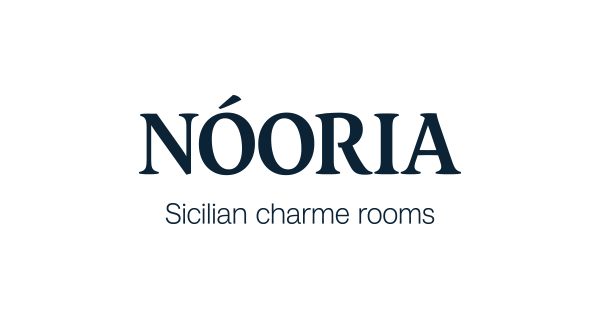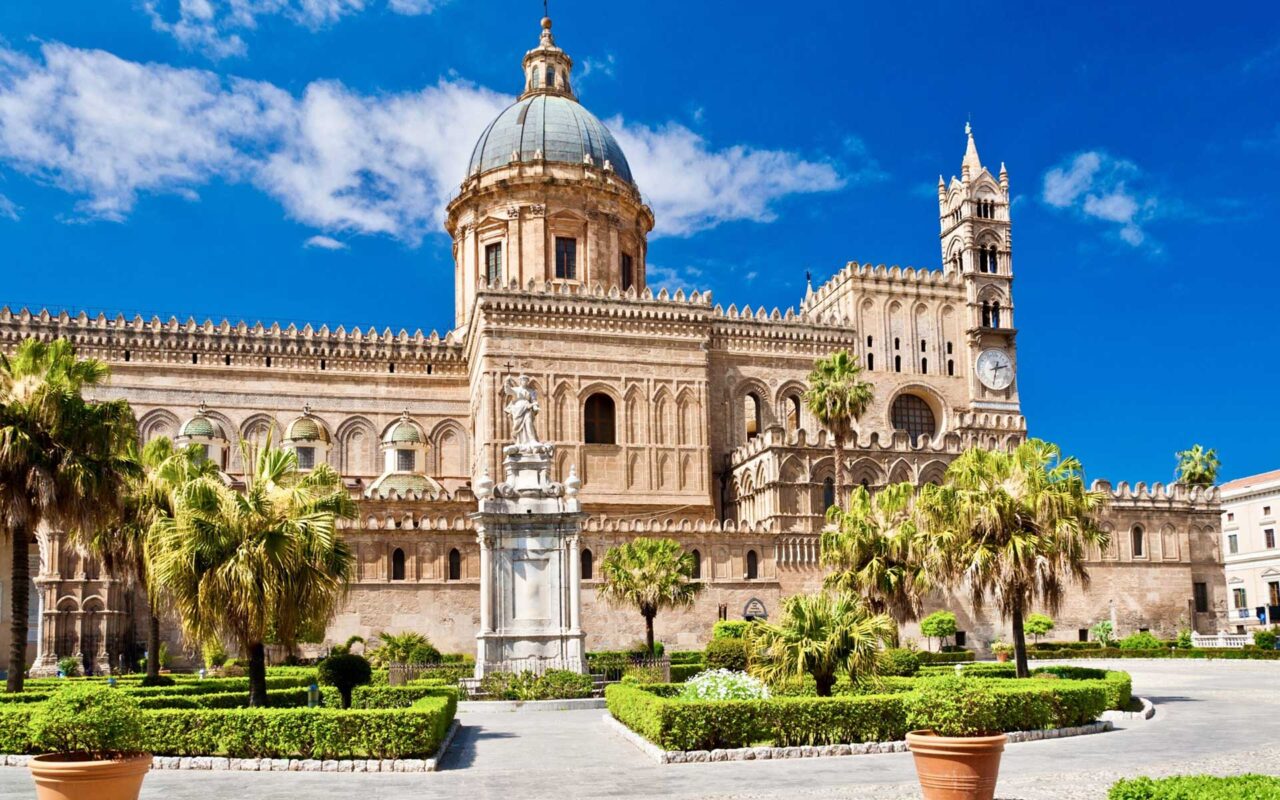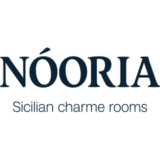Sicily, with its seven UNESCO world heritage sites, is the region with the highest number of awards in Italy. Among them we can find the Arab-Norman itinerary in Palermo and Monreale, which hold some great cultural and artistic heritage and were indeed included in 2015 in the World Heritage List. Its highly relevant artistic and architectural heritage contributed to the proclamation of Palermo as the capital of culture in 2018. Among its treasures, nine artistic monuments in arab-norman style: seven of them are in Palermo, one is in Monreale and the last one is in Cefalù.
Monuments of the Unesco Heritage Itinerary in Palermo
Palazzo Reale or Palazzo dei Normanni
It stands in the oldest part of the city, above a Punic settlement. It stands out for its majesty beyond the palm trees of Piazza della Vittoria. It was formerly the seat of the Norman kings and a magnificent medieval court. Today it is the seat of the Sicilian Regional Assembly and can only be visited four days a week. Visitors can see the council chamber and the sumptuous bedroom of Roger II, entirely covered with mosaics depicting peacocks, leopards and exotic landscapes. Inside the palace is a jewel of art: the Cappella Palatina, described by Guy de Maupassant as the most beautiful church in the world. It is located at Piazza Indipendenza, 1, Palermo.
Cappella Palatina
It is located on the lower floor of the Palazzo Reale and is considered to be Palermo’s greatest artistic treasure; a sumptuous place full of spirituality, completely covered in marble and fine mosaics. Greek-Byzantine mosaics made in 1140, incredibly sophisticated, full of detail in which movements and expressions emerge with extraordinary grace and delicacy.
Cattedrale Santa Vergine Maria Assunta
A grandiose and enchanting work, a great masterpiece of Sicilian art. Its interior houses the sarcophagus of Frederick II. The ‘Cathedral Treasury’ is kept in the crypt and comprises a collection of works of art dating from the Norman period to the 19th century. Beautiful is the crown of Frederick II of Swabia’s first wife, Empress Constance of Aragon. The Cathedral Roofs can also be visited. It is located in Corso Vittorio Emanuele, Palermo.
San Giovanni degli Eremiti
It is the emblem of the architectural fusion of the Arab and Norman styles. One cannot imagine Palermo without the presence of the five beautiful red domes that cover the roof of this singular church, bordering the city’s ancient medieval walls. Its architecture is based on geometric rigour, markedly Islamic, with severe interiors, stripped of all decoration; a tangible example of the exceptional dialogue that took place at that time between the two cultures, the Eastern and the Christian. The beauty of the place is enhanced by the presence of a beautiful 19th-century garden with palm trees that, around the ancient cloister, creates a true oasis of peace. It is located at Via dei Benedettini, 16, Palermo.
S. Maria dell’Ammiraglio (La Martorana)
In the ancient heart of Palermo, where the old city walls once stood, is the Church of Santa Maria dell’Ammiraglio, a true jewel of Byzantine art, also known as the Church of the ‘Martorana’, which owes its more common name to the presence of a Benedictine women’s monastery, founded in 1193 by Goffredo and Aloisia de Marturano, to whom King Alfonso ‘the Magnanimous’ granted the church in 1435. It is located at Piazza Bellini 3.
Chiesa di San Cataldo
It was built in 1154 during the reign of William I at the behest of Majone of Bari, as the chapel of a sumptuous palace, which no longer exists. It constitutes the most distinctive example of Arab architectural culture in the service of the Norman rulers with the typical red domes above it. The exterior walls are characterised by the graphic design of blind arcades surmounted by an ornamental crowning cyma. The interior, with a central plan, has three naves divided by columns with capitals supporting the pointed arches. The polychrome inlaid marble and porphyry floor and the altar in which a cross and the symbols of the evangelists are engraved are splendid. The church is now deconsecrated for worship. It is located at Piazza Bellini, 3.
Palazzo della Zisa
From the Arabic al-ʿAzīza, meaning ‘the splendid’ – was originally located outside the city and was the summer residence of the sovereign. Part of the great royal hunting grounds of the Genoardo (paradise of the earth), which stretched to the west of the city, the Zisa today can be easily reached on foot from the nearby Palazzo dei Normanni, which is only 1 km away. With its muqarna vaults, lattice windows, high battlements and beautiful fountains, the Zisa undoubtedly lives up to its name. Inside, today you can also visit a rich Museum of Islamic Art, collecting works from Sicily and the Mediterranean area produced between the 9th and 12th centuries. It is located in Piazza Zisa, Palermo
Ponte dell’Ammiraglio
It was built around 1131 at the behest of George of Antioch, admiral of King Roger II, to connect the city to the gardens across the Oreto river. Still today, the square, known as Piazza Scaffa, is a symbolic monument linking the city centre with the outlying Brancaccio area. The use of the characteristic very acute arches allowed the bridge to withstand very high loads; the opening of minor arches between the abutments of the large ones to lighten the structure and the pressure of the river below was also interesting. In fact, the bridge even withstood the terrible Flood of Palermo in February 1931 without any problems.At this bridge, on the night of 27 May 1860, Garibaldi’s troops defeated, in a fierce battle, the Bourbon troops that opposed their entry into the city. It is located in Via Corso dei Mille, Palermo.
Monuments of the Unesco Heritage Itinerary in Monreale
Cathedral of Monreale
It deserves great attention because it is truly one of the most beautiful temples in the world. After Hagia Sophia in Istanbul (Constantinople), it is the largest Byzantine mosaic work in the world. The word ‘mosaic’, in fact, comes from the Greek and means ‘patient work, worthy of the Muses’. Dedicated to Santa Maria la Nova, a masterpiece of Arab-Norman art, it was built by King William II of Altavilla, known as ‘the Good’, between 1172 and 1176. Inside, some 6400 square metres of mosaic cover the surface, according to an artistic representation of the Bible, a catechesis in images, so that people can immerse themselves in the sacred space. It is located in Piazza Gugliemo II, Monreale.
Cloister
To the right of the cathedral façade, in Piazza Guglielmo II, is the Cloister of the Benedictine Monastery, built in the late 12th century, a stupendous example of Byzantine architecture, in the centre of which is a fountain with a richly carved column in the shape of a palm tree shaft. Of particular note are the capitals, with sacred and profane scenes from the Old and New Testaments, and the beautiful, smooth, carved columns, decorated in relief with leaves, flowers, birds and other animals.
What are the main features of the Arab-Norman style?
- The Byzantine influence emerges above all in the architecture, with a preference for the square basilica plan with a central Greek cross covered by a barrel vault. But also in the presence of mosaics depicting characters and various decorative motifs: the most characteristic is the Christ Pantocrator.
- The Romanesque element is instead evident through the use of the Latin cross plan and massive towers on the façade.
- Finally, the Arab character is evident from the use of pointed arches, but above all the distinctive Moorish arches. Furthermore, the Arab style is characterised by the absence of figurative sculpture: decoration gives way to geometry and arabesques.


